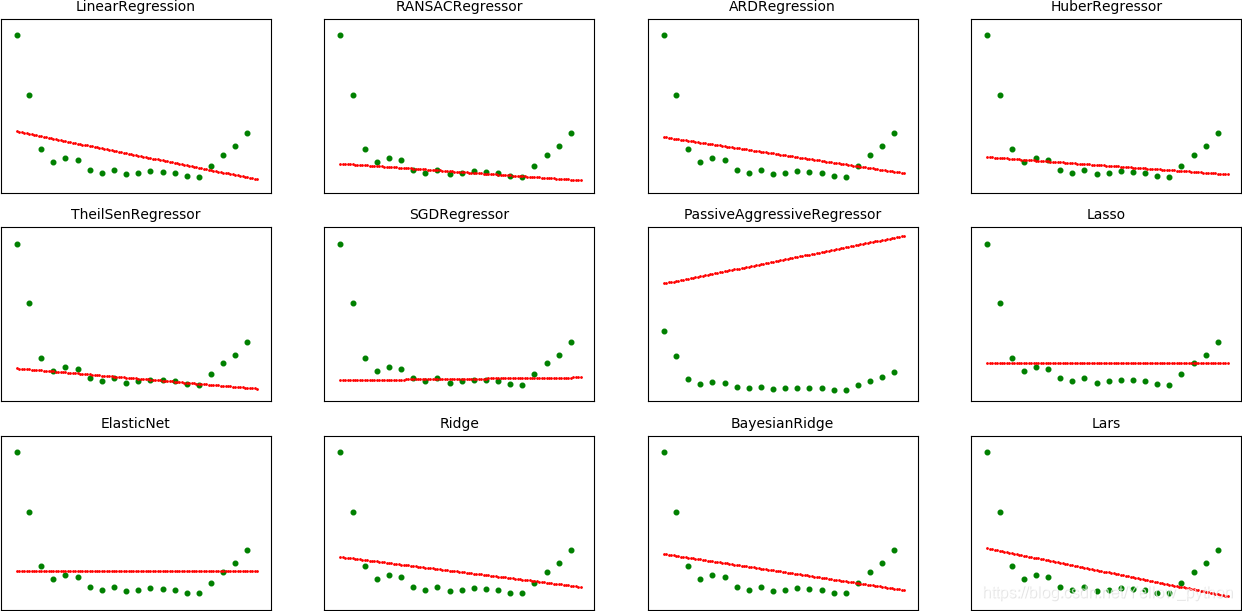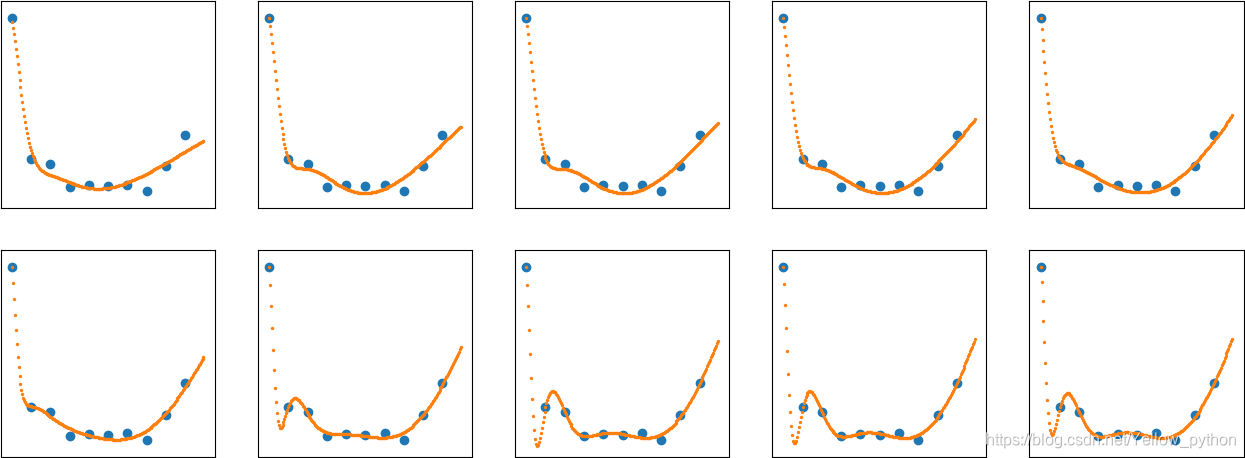非线性样本

from matplotlib import pyplot as mp
y = [.4187, .0964, .0853, .0305, .0358, .0338, .0368, .0222, .0798, .1515]
x = [[i]for i in range(len(y))]
mp.scatter(x, y, s=99)
mp.show()
Sklearn回归汇总


import matplotlib.pyplot as mp
# 训练集
y = [.27, .16, .06, .036, .044, .04, .022, .017, .022, .014, .017, .02, .019, .017, .011, .01, .03, .05, .066, .09]
ly, n = len(y), 100
x = [[i / ly]for i in range(ly)]
# 待测集
w = [[i / n] for i in range(n)]
# # x轴范围
# max_x = 1
# x, w = [[i[0]*max_x] for i in x], [[i[0]*max_x] for i in w]
def modeling(models):
for i in range(len(models)):
print(models[i].__name__)
# 建模、拟合
model = models[i]()
model.fit(x, y)
# 预测
z = model.predict(w)
# 可视化
mp.subplot(3, 4, i + 1)
mp.title(models[i].__name__, size=10)
mp.xticks(())
mp.yticks(())
mp.scatter(x, y, s=11, color='g')
mp.scatter(w, z, s=1, color='r')
mp.show()
from sklearn.neighbors import KNeighborsRegressor, RadiusNeighborsRegressor
from sklearn.ensemble import GradientBoostingRegressor, AdaBoostRegressor,\
RandomForestRegressor, BaggingRegressor, ExtraTreesRegressor, VotingRegressor
from sklearn.tree import DecisionTreeRegressor, ExtraTreeRegressor
from sklearn.svm import SVR
from sklearn.neural_network import MLPRegressor
from sklearn.gaussian_process import GaussianProcessRegressor
modeling([
KNeighborsRegressor, RadiusNeighborsRegressor,
GradientBoostingRegressor, AdaBoostRegressor, RandomForestRegressor, BaggingRegressor, ExtraTreesRegressor,
# VotingRegressor,
DecisionTreeRegressor, ExtraTreeRegressor,
SVR, MLPRegressor, GaussianProcessRegressor
])
from sklearn.linear_model import LinearRegression, RANSACRegressor, ARDRegression, HuberRegressor, TheilSenRegressor,\
SGDRegressor, PassiveAggressiveRegressor, Lasso, ElasticNet, Ridge, BayesianRidge, Lars
modeling([
LinearRegression, RANSACRegressor, ARDRegression, HuberRegressor, TheilSenRegressor,
SGDRegressor, PassiveAggressiveRegressor, Lasso, ElasticNet, Ridge, BayesianRidge, Lars
])
决策树
import matplotlib.pyplot as mp
# 训练集
y = [.4187, .0964, .0853, .0305, .0358, .0338, .0368, .0222, .0798, .1515]
x = [[i]for i in range(len(y))]
# 待测集
w = [[i / 100 * len(y)] for i in range(100)]
def modeling(models):
n = len(models)
for i in range(n):
# 建模、拟合
models[i].fit(x, y)
# 预测
z = models[i].predict(w)
# 可视化
mp.subplot(1, n, i + 1)
mp.scatter(x, y, s=22, color='g')
mp.scatter(w, z, s=2, color='r')
mp.show()
from sklearn.tree import DecisionTreeRegressor
modeling([
DecisionTreeRegressor(max_depth=1),
DecisionTreeRegressor(max_depth=2),
DecisionTreeRegressor(max_depth=3),
DecisionTreeRegressor(max_depth=4),
DecisionTreeRegressor(),
])

随机森林
import matplotlib.pyplot as mp
# 训练集
y = [.4187, .0964, .0853, .0305, .0358, .0338, .0368, .0222, .0798, .1515]
x = [[i]for i in range(len(y))]
# 待测集
w = [[i / 100 * len(y)] for i in range(100)]
def modeling(models):
n = len(models)
for i in range(n):
# 建模、拟合
models[i].fit(x, y)
# 预测
z = models[i].predict(w)
# 可视化
mp.subplot(1, n, i + 1)
mp.scatter(x, y, s=22, color='g')
mp.scatter(w, z, s=2, color='r')
mp.show()
from sklearn.ensemble import RandomForestRegressor
modeling([
RandomForestRegressor(max_depth=1),
RandomForestRegressor(max_depth=2),
RandomForestRegressor(),
])

高斯过程
高斯过程回归:使用高斯过程先验对数据进行回归分析的非参数模型(non-parameteric model)
算法特征:计算开销大,通常用于低维和小样本的回归问题
应用领域:时间序列分析、图像处理和自动控制等
from sklearn.gaussian_process import GaussianProcessRegressor
import matplotlib.pyplot as mp, random
# 创建样本
a = [199, 188, 170, 157, 118, 99, 69, 44, 22, 1, 5, 9, 15, 21, 30, 40, 50, 60, 70, 79, 88, 97, 99, 98, 70, 46, 39, 33]
for e, y in enumerate((a, [a[i//2]+random.randint(0, 30) for i in range(len(a)*2)])):
# 待测集
ly, n = len(y), 2000
w = [[i / n * 1.2 - .1] for i in range(n)]
# 建模、拟合、预测
model = GaussianProcessRegressor()
model.fit([[i/ly]for i in range(ly)], y)
z = model.predict(w)
# 可视化
mp.subplot(1, 2, e + 1)
mp.yticks(())
mp.bar([i/ly for i in range(ly)], y, width=.7/ly)
mp.scatter(w, z, s=1, color='r')
mp.show()

Keras神经网络
from matplotlib import pyplot
from keras.models import Sequential
from keras.layers import Dense
from keras.optimizers import Adam
# 训练集
y = [.27, .16, .06, .036, .044, .04, .022, .017, .022, .014, .017, .02, .019, .017, .011, .01, .03, .05, .066, .09]
x = list(range(len(y)))
# 待测集
n = 200
w = [i/n*len(y) for i in range(n)]
# 建模
model = Sequential()
model.add(Dense(units=10, input_dim=1, activation='sigmoid'))
model.add(Dense(units=1, activation='sigmoid'))
# 编译、优化
model.compile(optimizer=Adam(), loss='mse')
for i in range(10):
# 训练
model.fit(x, y, epochs=2500, verbose=0)
print(i, 'loss', model.evaluate(x, y, verbose=0))
# 预测
z = model.predict(w)
# 可视化
pyplot.subplot(2, 5, i + 1)
pyplot.xticks(())
pyplot.yticks(())
pyplot.scatter(x, y) # 样本点
pyplot.scatter(w, z, s=2) # 预测线
pyplot.show()
